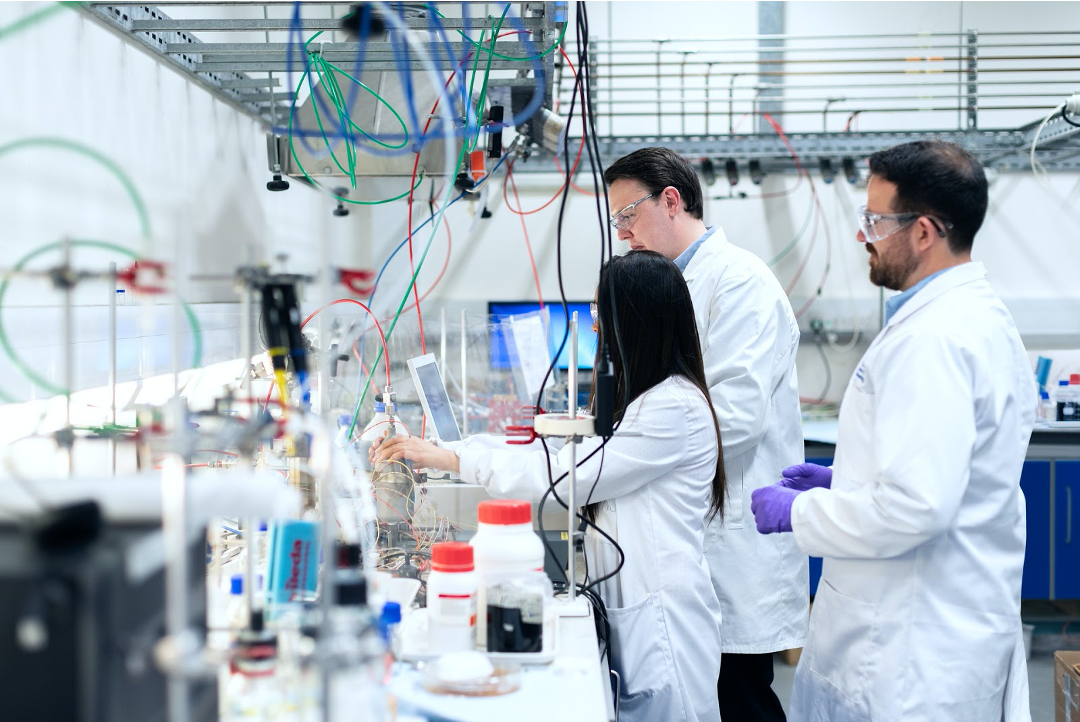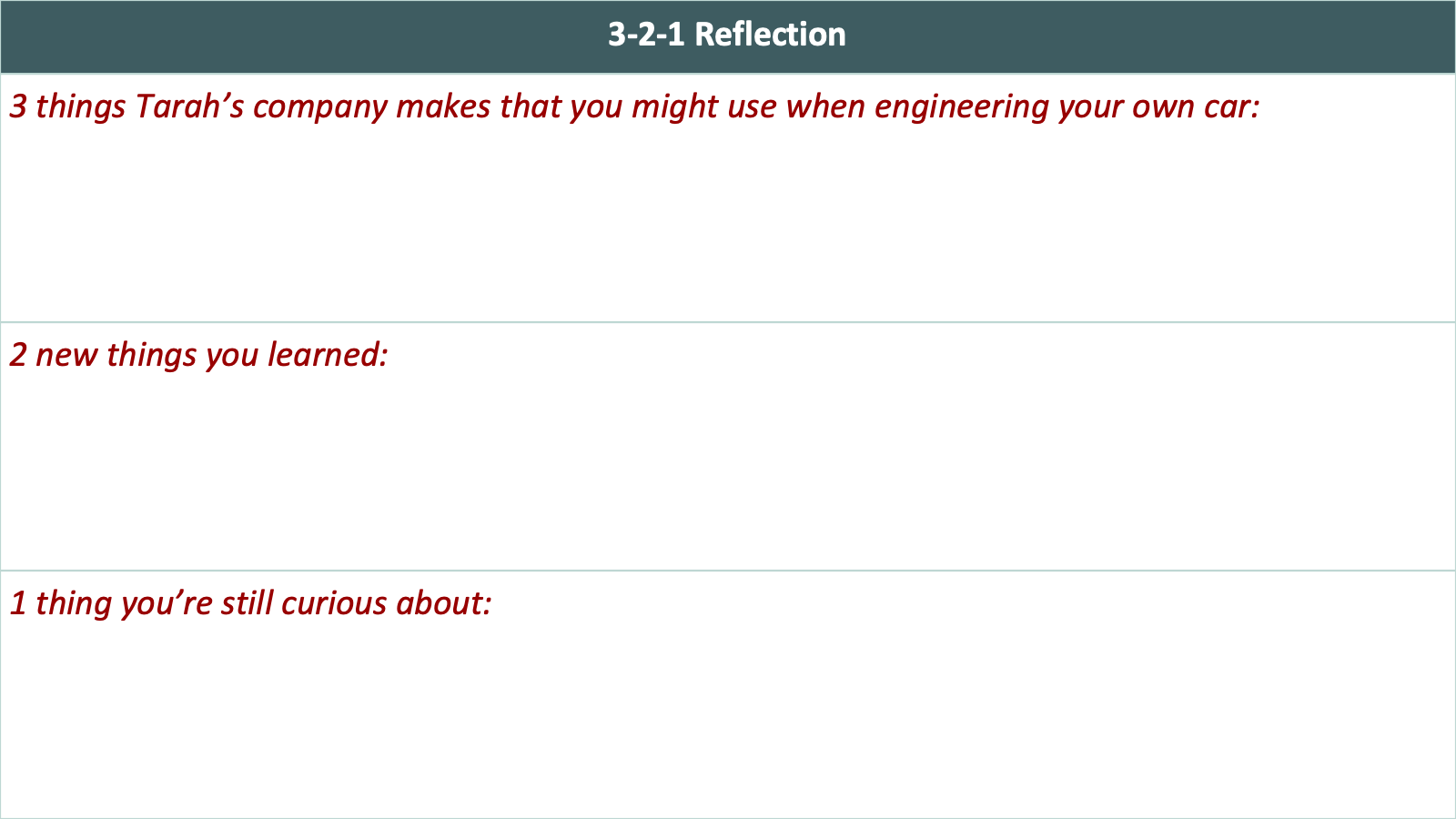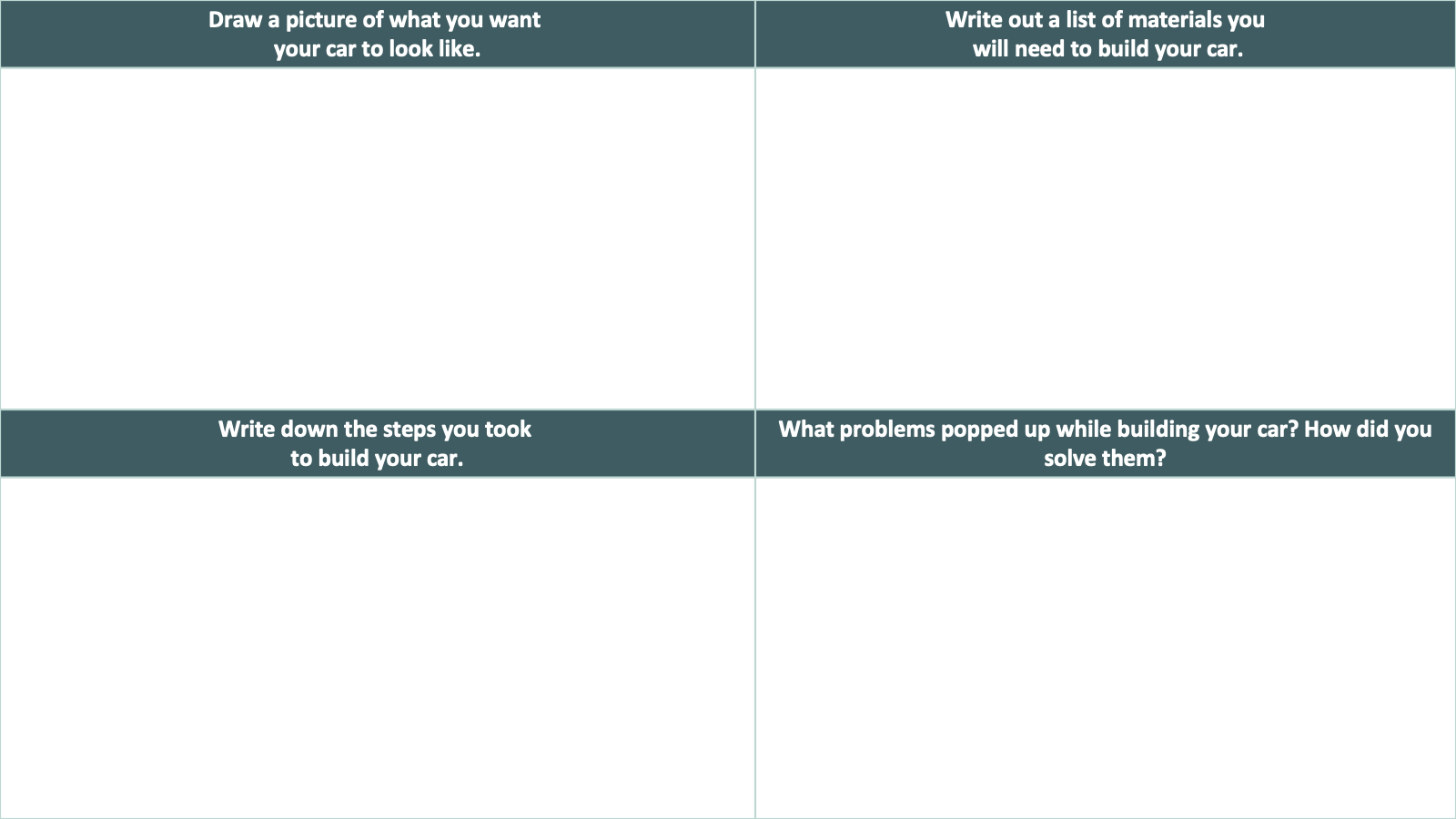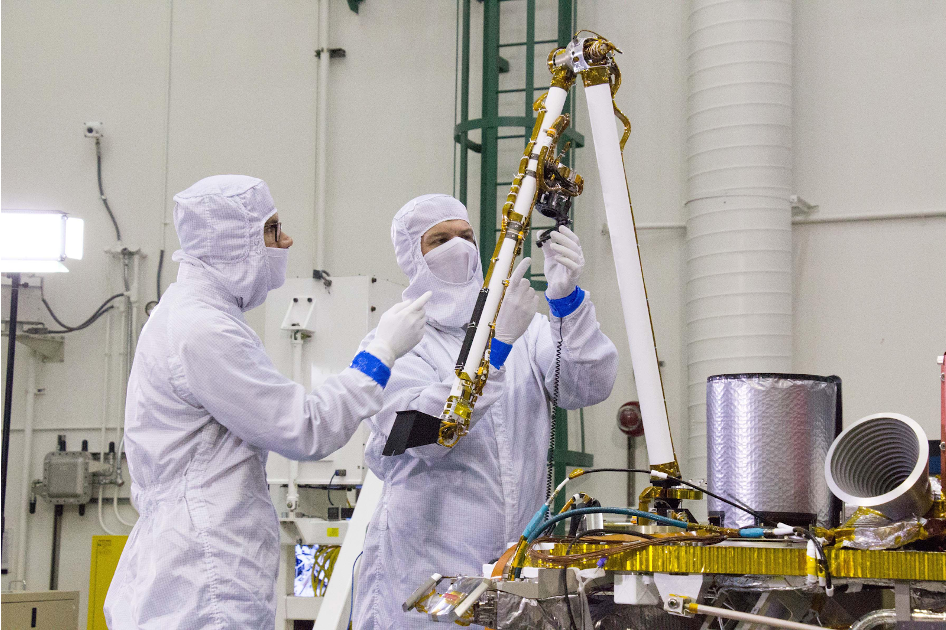Summary
Workers in STEM fields provide research and services related to science, technology, engineering, and math. Those in this field gather and examine information, solve problems, and apply their findings. One such career that falls into this cluster is chemical engineering. In this activity, you will explore the many facets of chemical engineering, from building items to mixing solutions to solving problems. You will watch an interview with a real-life chemical engineer, engineer your own car, and mix your own chemical solution.
Overview

Careers in the STEM field ask workers to provide research and services related to science, technology, engineering, and math. Workers in this field gather and examine information, solve problems, and apply their findings. One of the many careers that falls into the Science, Technology, Engineering, and Mathematics cluster that might catch your attention is chemical engineering. This activity will allow you to explore different parts of chemical engineering from building items to mixing solutions to solving problems.

A person who works in chemical engineering is called a chemical engineer. Sometimes chemical engineers are also called "universal engineers" because they have extensive backgrounds in various areas of science and engineering. Each day they use math, chemistry, physics, and economics to solve real-world problems. The average salary for a chemical engineer is $108,770 but can range from $66,810 up to $176,090, depending on postsecondary education and experience.
Chemical engineers have many roles and responsibilities. They might:
Design and invent new processes.
Develop new materials.
Learn how to make current processes less expensive and more environmentally friendly.
Learn how to increase productivity for current systems.
Find safer ways to work with dangerous chemicals.
Troubleshoot problems.
Develop ways to separate different components of liquids and gases or ways to generate electrical currents through chemical processes.
Conduct tests and make observations.
In order to be a chemical engineer, you must have a bachelor’s degree in chemical engineering or a degree in a similar field such as chemistry, math, or another type of engineering. In order to complete this degree program, you must complete all classroom requirements, laboratory requirements, and field studies.
While you are in high school, you can take science courses like chemistry, physics, and biology, and math courses like algebra, trigonometry, and calculus. You can also attend engineering summer programs to see what chemical engineers do. You may want to take some time to look up summer programs near you using the Engineering Education Service Center. Sometimes, attending these programs can help you plan additional courses you need to take while you’re in high school.
Chemical engineers need a wide range of skills in order to be successful in their jobs, including:
Analytical Skills. When designs do not work as planned, chemical engineers must analyze the situation to find answers.
Problem-Solving Skills. Chemical engineers need to predict potential problems and solutions around safety and manufacturing.
Creativity. Chemical engineers get to invent new materials, design manufacturing techniques, and explore creative new applications in chemical and biomedical engineering.
Ingenuity. Chemical engineers take big ideas and cleverly apply them to specific problems in the creation process.
Interpersonal Skills. Chemical engineers need to develop good working relationships with others. They often work as part of a team to solve problems.
Math Skills. Chemical engineers use calculus and other advanced math skills daily.
Activity #1: Career Talk
Before you engineer your own car, let's learn more about what it means to be a chemical engineer from a professional in the field! Tarah Schneberger has both her bachelor's and master's degrees in chemical engineering. Tarah currently works for Chevron Phillips Chemical Company.
Watch her career talk to learn more about what it’s like to be a full-time chemical engineer and discover all the resources chemical engineers create each day!
After viewing Tarah’s career talk, reflect on the video by completing the 3-2-1 writing activity. You can find a printable version of this in the attached Student Guide.

Activity #2: Engineering a Car
Before we create the fuel for our Chemical Reaction Car, let’s do some tinkering to build the car itself. As we learned from Tarah, part of engineering is tinkering to build things or to solve problems, so get creative with the car you build! It can be something as simple as grabbing an old toy car, digging up your old building bricks to design something new, or creating something in between. How you build your car is up to you, but make sure that whatever you decide, your car has four wheels and a sturdy base. Begin by reading the instructions below for building a car.
Materials
Building materials (such as building bricks in a variety of sizes, shapes, and colors) or a building base (such as a toy car)
Window Notes sheet (found on the next page)
Pencil or pen
Important Note:
You will be using this car in the next activity, so it will need to be big enough to hold a plastic bottle on top.
Instructions
Using your Window Notes sheet (found in the attached handout):
Draw a picture of what you want your car to look like and write out a list of materials that you will need to build your car.
Now that you have a plan for constructing it, step into the role of an engineer, and build your car! On your Window Notes sheet, document the steps you take to build your car so that other engineers will be able to follow the same steps.
After you’re finished building your car, return to your Window Notes sheet and reflect on any issues you had. What problems popped up while building your car? How did you solve them?

Extend
Still interested in becoming a chemical engineer? Check out My Next Move to discover more about chemical engineers, what they do, and the knowledge, skills, and abilities needed in the field.
Did you know that chemical engineering isn’t the only specialty in the Science, Technology, Engineering, and Math (STEM) cluster? Check out the careers classified as Professional, Science, and Technical, and those classified as Manufacturing to see all the STEM-based career options in this cluster!

Activity #3: Chemical Reaction Car
Chemical engineers work on a variety of tasks that range from building items to mixing solutions to solving problems. As a chemical engineer, you’d get the chance to try all these things individually and together. In this activity, you’ll build on the car you engineered earlier. Before long, you’ll know how to send it rocketing down the sidewalk!
Disclaimer Statement
This activity is considered safe when conducted as written. Read and follow the safety and first aid guidelines below. While there are no specific safety hazards associated with any of the chemicals used in this activity, make sure to ask an adult to help because chemicals and flying objects are involved.
Safety and First Aid
Ask for an adult’s help with this activity because chemicals and flying objects are used.
Read all of the instructions before you begin.
Wear the following personal protective equipment (PPE):
Goggles, glasses, or sunglasses
Gloves (if you are allergic to baking soda or vinegar)
Do not ingest any of the materials.
Conduct the activity outside—it will be messy.
Before you begin, watch the Amoeba Sisters’ video on general lab safety.
First aid instructions: Wash the affected area with water.
Materials
PPE (Goggles, glasses, or sunglasses)
Baking soda
Vinegar
Empty plastic bottle with cap
Single-ply tissue paper
Funnel
Duct tape
Car (from earlier activity)
Measuring spoon
Hole punch or needle
Camera (optional)
Instructions
Using duct tape, tape the empty bottle to your car. The opening of the bottle should be pointing in the same direction as the back of the car.
Poke a hole in the cap of the bottle using the hole punch or needle. Be careful! If you have trouble, ask your adult supervisor to help you.
Take the cap off of the bottle and use the funnel to pour vinegar into the bottle. Fill the bottle so that it is between one-half and two-thirds full.
On a table, lay out one piece of single-ply tissue paper. If you don’t have single-ply, you can pull the sheets of multi-ply tissue paper apart.
Pour 2 Tablespoons of baking soda onto the middle of the tissue. Roll it into a log.
Take all of your materials outside (if you have not done so already) and get your camera ready if you are using one!
Carefully push the baking soda tissue into the bottle.
Quickly screw the cap onto the bottle and hold your finger over the hole.
Gently shake the bottle so that the tissue disintegrates and the baking soda and vinegar mix.
Put your car down on the ground and, when you’re ready, remove your finger. Watch your car go flying!
Create and share a GramIt summary of your experiment with the class, including an image and a hashtag.
Sources
All of the sources that were linked throughout the activity are listed below. Providing a list of sources allows us to give credit for the work someone else made.
Amoeba Sisters. (2017, Aut. 13). General lab safety [Video]. YouTube. https://www.youtube.com/watch?v=MEIXRLcC6RA
CollegeGrad. (n.d.). Chemical engineers. Career Profiles and Employment Projections. https://collegegrad.com/careers/chemical-engineers
Cub Scout Ideas. (n.d.). How to build an awesome chemical reaction car. https://cubscoutideas.com/8156/chemical-reaction-car
Helmenstine, A.M. (n.d.). What do chemical engineers do and how much do they make?. https://www.thoughtco.com/what-chemical-engineers-do-and-salary-range-604018
K20 Center. (n.d.). 3-2-1. Strategies. https://learn.k20center.ou.edu/strategy/d9908066f654727934df7bf4f5059a7b
K20 Center. (2020, July 14). Chemical engineer - Tarah Schneberger - Zoom into your career [Video]. YouTube. https://www.youtube.com/watch?v=55BeMSeHOKY
K20 Center. (n.d.). Gramit. Strategies. https://learn.k20center.ou.edu/strategy/2554
K20 Center. (n.d.). Window Notes. Strategies. https://learn.k20center.ou.edu/strategy/fc74060730ea745c8c4f356aa2015ac0
Minnesota State University. (n.d.). Science, technology, engineering, and mathematics. CAREERWise. https://careerwise.minnstate.edu/careers/stem.html
My Next Move. (n.d.) Chemical engineers. https://www.mynextmove.org/profile/summary/17-2041.00
My Next Move. (n.d.) Careers in manufacturing. https://www.mynextmove.org/find/browse?c=31
My Next Move. (n.d.) Careers in professional, science, and technical. https://www.mynextmove.org/find/browse?c=54
NASA/JPL-Caltech/Lockheed Martin Space. (n.d.). Pre-launch testing of InSight's robotic arm. NASA. https://www.jpl.nasa.gov/spaceimages/details.php?id=PIA22741
Royal Academy of Engineering. (2020). Engineer. Pixabay. https://pixabay.com/photos/engineer-engineering-chemical-4915425/
Washington Office of Superintendent of Public Instruction. (n.d.). Careers in STEM. Student Success. https://www.k12.wa.us/student-success/career-technical-education/career-technical-education-pathways/science-technology/careers-stem


